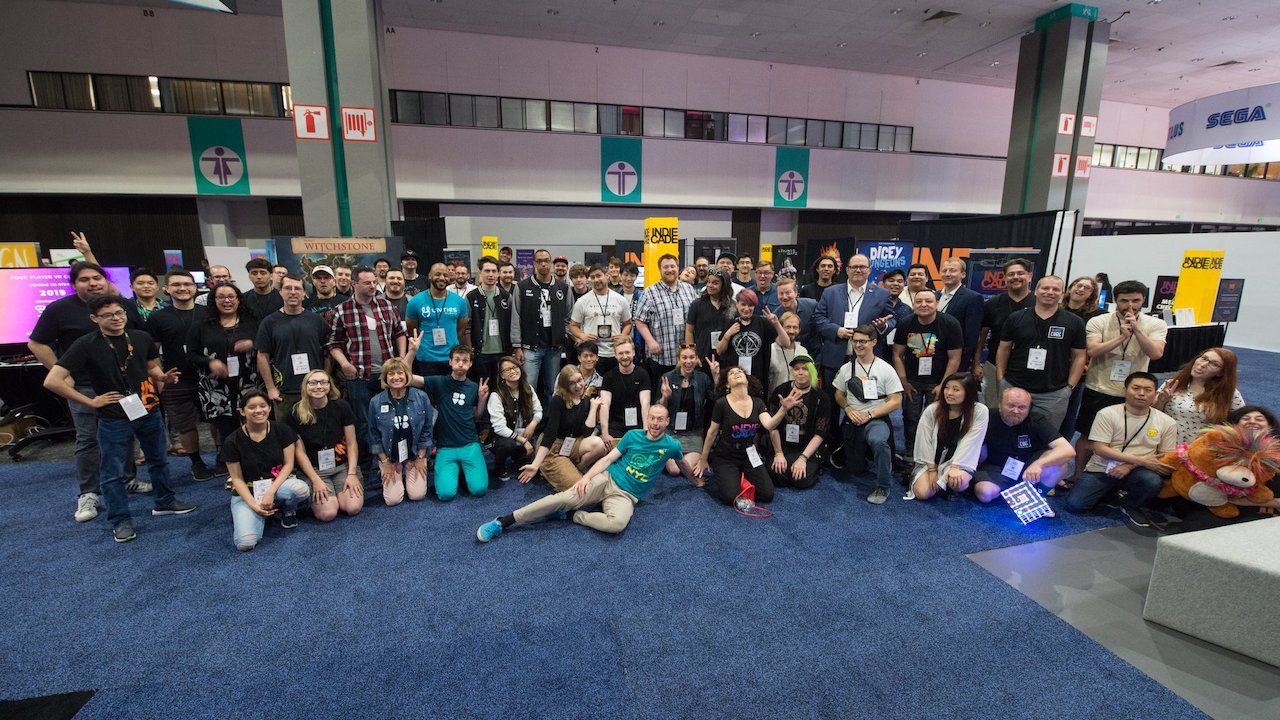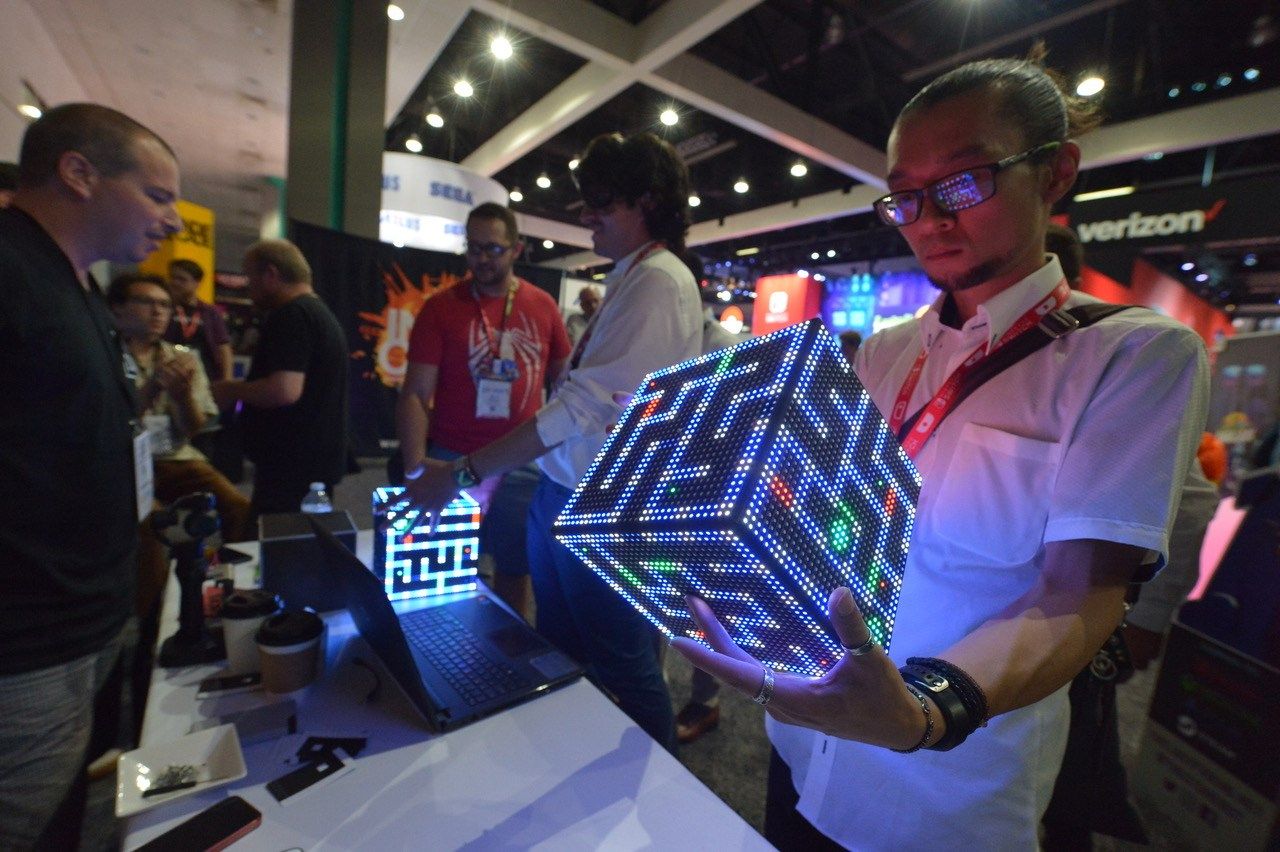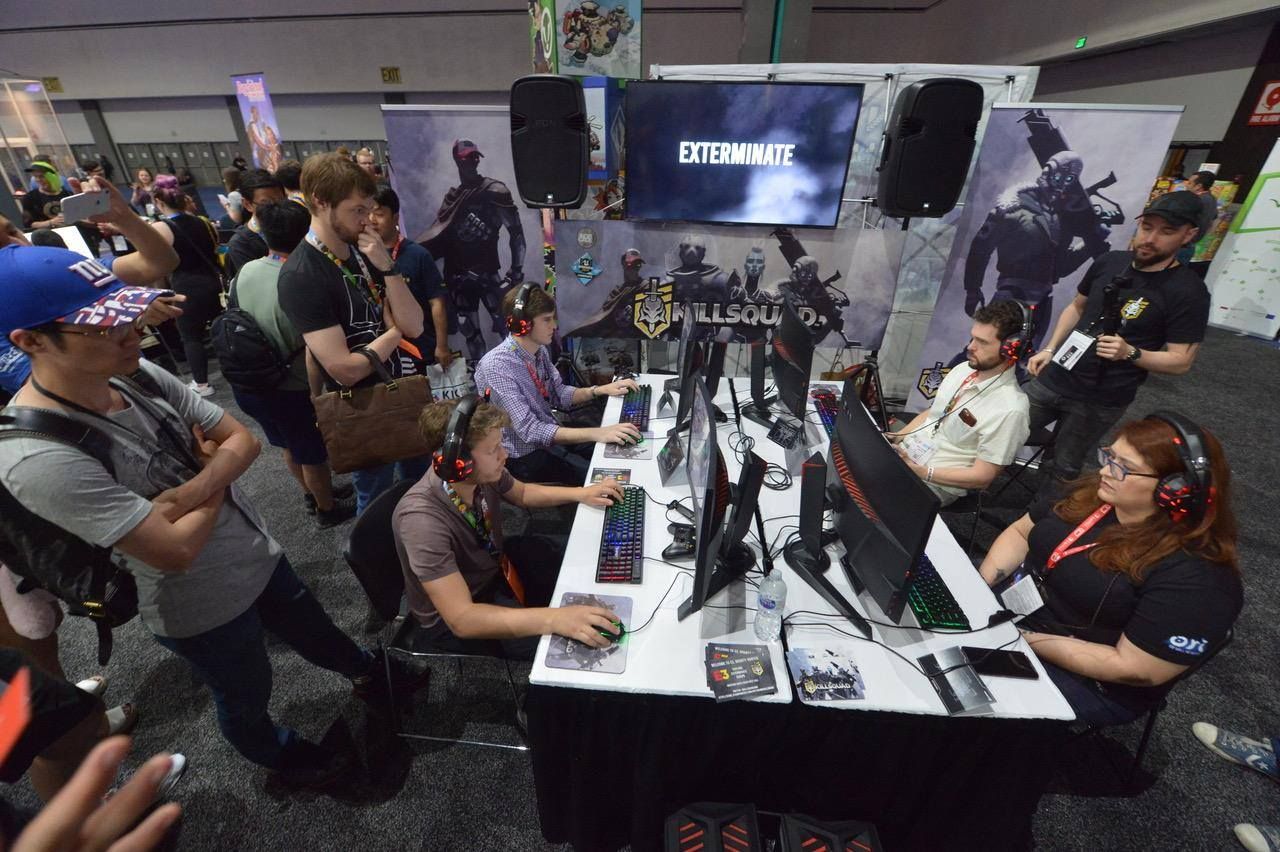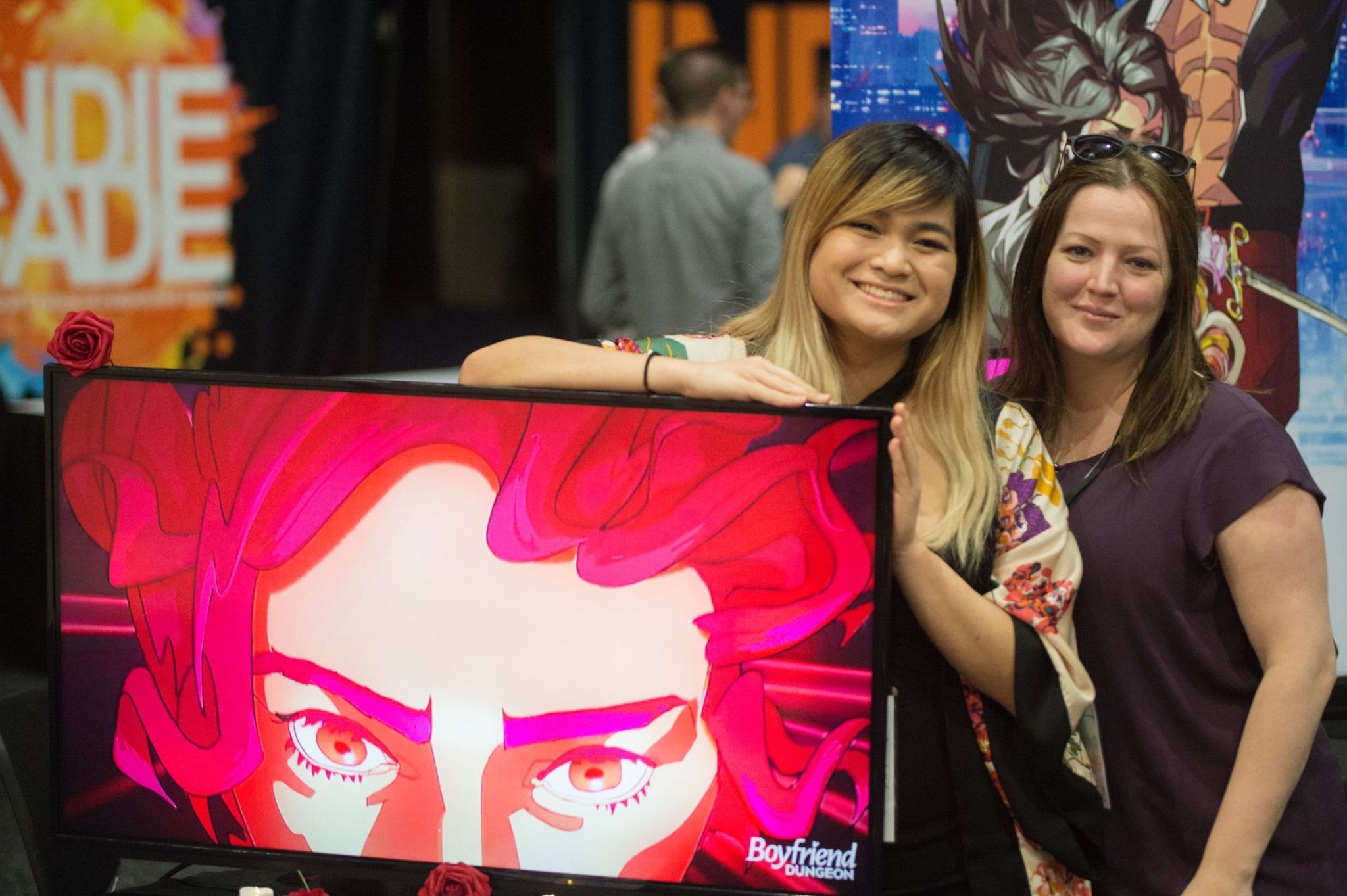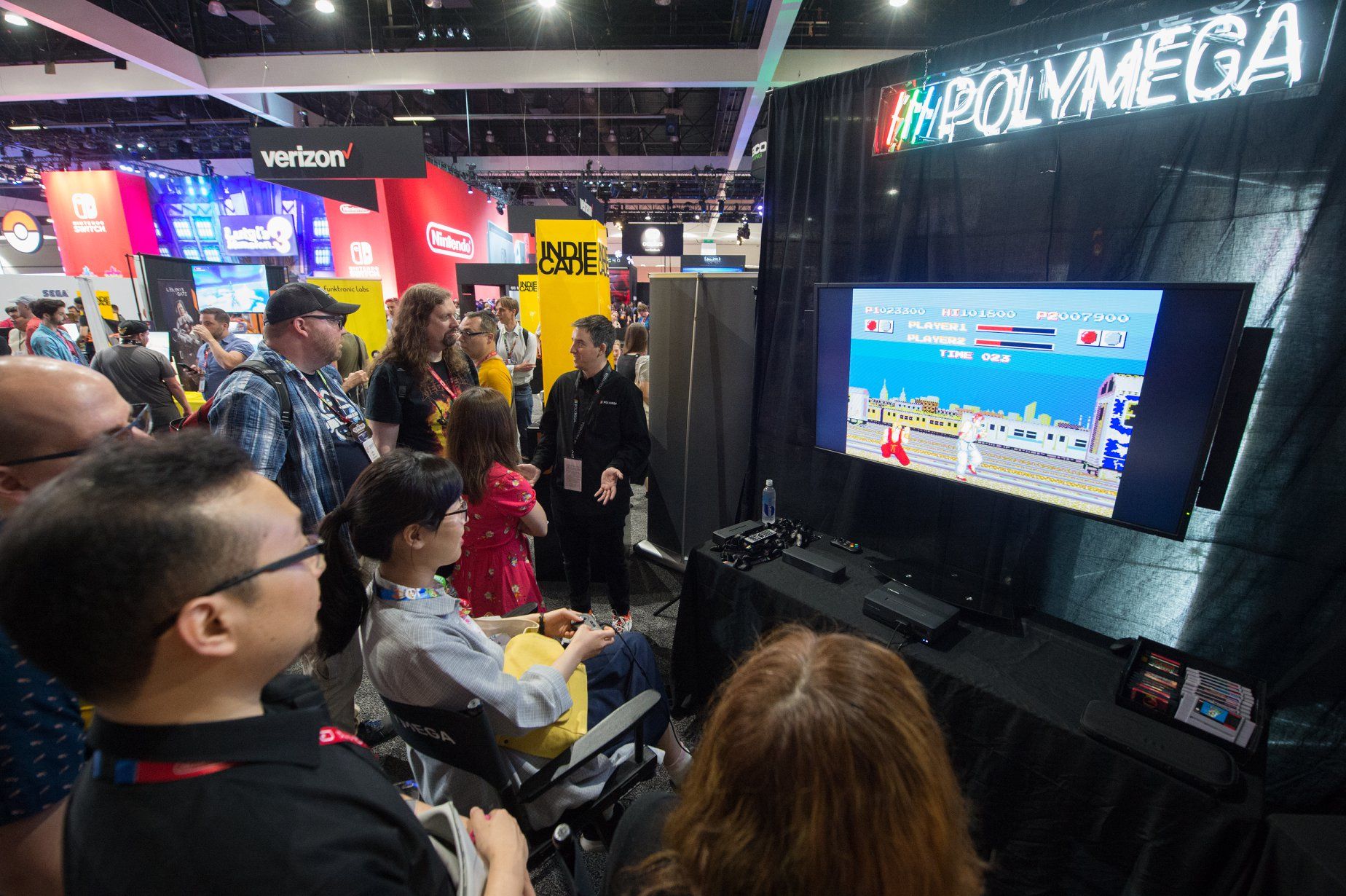In a corner of the Los Angeles Convention Center's West Hall, you can find a glowing cube covered with LED lights. This is PiXXL Maze, a part of IndieCade's showcase at E3 2019. This cube might not be exactly what one would expect to find at the IndieCade booth, but that's because IndieCade is more about independent video games: it's about the concept of play. Specifically, a type of play that is a part of video games as a social outlet.
At the IndieCade booth, I saw a number of other experiences besides PiXXL Maze, including Infinite Children, Keen, Killer Queen Black, Knife Sisters, and Boyfriend Dungeon (check out my brief previews of those titles). Those were only just a few of many titles at the booth that exemplified the IndieCade organization's spirit of play.
IndieCade has been a part of E3 for over a decade, and since then has held a number of international events and festivals showcasing the latest and most innovative developments of not just games, but interactive mediums in general. This was the mission that Festival Director Sam Roberts described to me in detail, as I sat down with him on the E3 2019 show floor for an extended conversation.
Chris: For people who don’t really know what IndieCade is all about, can you briefly describe your mission?
Sam Roberts: IndieCade is the international festival of play, and our mission is to promote innovation and diversity in play experiences. Those two things are closely, closely interrelated; we are looking for people making new kinds of games, new kinds of mechanics, being made by different kinds of people for different audiences. telling different kinds of stories, exploring new or different kinds of meanings. So our festival shows board games, RPGs, LARPs, video games, mobile games, VR, AR, immersive theater, escape rooms—anything that is playful or interactive, we are interested in bringing and making a part of our community. And that is actually how we drive innovation and diversity and artistry, by exposing different parts of our community to other really interesting work that may inform their work. Showing really cool puzzle designs to escape room designers and they can integrate those, bringing immersive theater down and showing video game people how they design spaces with narratives and how that can affect their video games.
CC: Would you describe IndieCade as almost like a hub or a network?
SR: Yeah! IndieCade is above and beyond all else a community of people who are interested in innovating play in different ways, exploring lots of different kinds of experience design and creativity, and who celebrate how awesome all their stuff is together and learn from one another. People who are in the festival go on to become our jury, attendees become people who submit games and are in the festival; a lot of our sessions at the festival exist to help people who love these games start figuring how to make them or enter the space.
[pullquote]"IndieCade is the international festival of play, and our mission is to promote innovation and diversity in play experiences."[/pullquote]
CC: Have you seen indie developers react to recent industry trends, such as VR and streaming?
SR: I get to see microtrends because we get so many submissions that I get to see stuff that you might not catch that’s happening and weird, often a few years ahead of time. For instance, we have a bunch of games this year that are developers trying to build out and innovate narrative or larger structures on pinball. Like, for pinball adventures games, pinball RPGs—you see a couple of those things out there, but I get all of these submissions and I can actually say “something’s going on: everyone’s into pinball right now.” But I actually think it’s directly related to streaming.
Pinball is a thing that we’re conditioned to think about people playing and watching them play and you are good at and you can be good at in a way that people can’t be good at, and so it’s flashy and beautiful and it has all of this feedback, and that’s stuff that plays well on streaming. I think you also then see a lot of push in indie devs right now for co-op or competitive games that allow for interesting multiplayer streaming. This is a huge broad trend, but video games as an industry took gaming in a very solo direction for a while, where you played games by yourself, whereas the history of playing games, that was not the case. Right? You would always play games with other people. The technology has caught up to the point where broadly, not just indies, but mainstream industry, I think you start to see a push back toward sociability. And that’s what streaming is about too—it’s a different way to make solo games potentially social, and then certainly esports competition and all of that.
It’s also why I think AR is interesting. I think for thousands of years we’ve made play experiences and games, and then we made this awesome thing called the computer and enabled all of these new kinds of play, just like it enabled all this other shit we do now in society, like GPS and texting and whatnot. And a huge part of the arc of culture right is about taking the good stuff we got from the computer and reintegrating it back into human life at large. How we can be online and not be in our tiny weird alone box. So I think that’s the big trend of what’s happening now. I think people are attacking it from a bunch of new directions. That’s why board games are in a huge recovery because they tend to be naturally social, you play them with people, there’s no screen to get caught up in, you have to talk and engage. It’s also why I think immersive theater is connected to all that. This is stuff we do with people, like in an escape room—we’re all playing together, but we’re using our bodies, we’re physical, but now we’re assisting it with technology, right? We’re building technological puzzles that can be embedded in real space or AR we’re chasing Pokemon everywhere.
CC: Have you seen any trends in art style or graphical design?
SR: I think anime is a look right now. It’s very, very popular. You can see it on the show floor, not just in our indie booth—I mean, we’re right next to Sega and Atlus, but a ton of their products are getting big HD revs on what is essentially a big hand-drawn anime style. The thing that I’ve seen a little bit of are two things: not quite abstract 3D, right? There was a period where abstract 3D was everything, where it was just like white spaces and all that weirdness. And then you get stuff like Manifold Garden over there [at the IndieCade booth] which is usually a lot of lighting and a lot of rendered definition to make a beautiful space. It's very underdesigned, it's not overdesigned.
And then I'm starting to see chibi stuff, which makes sense, right? We're in that, but we've been through the pixel art coming back and now it's time to get our chibi-headed 3D models, right? It's time. One of the things I see that interests me because it often has a technological innovation component to it is people trying to figure out how to do really nice moving hand-drawn animation. Stuff that looks like that beautiful hand-drawn Japanese or other kinds of hand-drawn, but it has motion and animation to it that captures all that feeling you get from an 80s Disney movie or something like that, but is being rendered by a computer.
And that there are interesting technological challenges in that. And I see people do really interesting things including like, "I'm gonna paint a ton of watercolors, and import them as 2D assets and turn them into objects in Unity and then see how I can animate these watercolors to make cool stuff happen." Those sort of workflows that are just emerging from technology now that you couldn't even figure out how to approach ten or fifteen years ago are where my favorite visual stuff is at.
[pullquote]" Those sort of workflows that are just emerging from technology now that you couldn't even figure out how to approach ten or fifteen years ago are where my favorite visual stuff is at."[/pullquote]
CC: How much can you speak to the relationship between indie developers and AAA publishers? For instance, my colleagues saw a presentation about EA Originals where indie developers had testimonials complimenting their partnerships with EA. On the other hand, you might see horror stories from contractors or other developers who don't have that much of a great experience with bigger companies.
SR: It ends up being very case-by-case. And in fact, a lot of big companies have cyclical relationships with indie devs. They work very hard to get good relationships when it has been decided at a corporate level that they need to improve their indie slate or their indie participation or whatever. They invest time and energy, they hire people who care, and then those people fic the problem or get fired and move on and the company gets worse. So EA has both been terrible and good. For a long time, EA was really great, because they're the ones EA Wife happened to, and they had to take it seriously in a way that other people didn't. And in the same sense, they're particularly here working with indies; there's been a clear [progression]—it was Microsoft, then it was Sony, and then it was Nintendo, then it was Sony again, now Microsoft is making a play for [indies] again.
I've published and worked with devs on all these platforms as indies publishing and using their stuff, and depending on where a company is, you will get a lot of technical support as an indie in their open system, or you'll get none. Some of them have different ways they get tagged, and it's hard to sort all of that stuff out. In general, what I would say is if you are an indie dev, deal with the relationship in front of you. If they come to you and they're treating you well, you can probably do that. And if they're not, don't let them. Walk away, it's fine. In the same sense, the AAA industry benefits a lot from indies establishing audiences and trends that AAA can then invest in and take to a larger scale.
It's a broken old example, but Fortnite was basically an indie game. Nobody thought you made games like that and made money with that, and then they made a grotesque amount of money, and now everyone is making a Fortnite-like. It just happens. There's a lot of competitive team base stuff that all is been in the space and slowly bubbles up. VR and AR, in particular, there's no established way you make this stuff. So both film companies and game companies are looking at indie devs who are doing interesting interactive work in this space.
CC: Having never been to an IndieCade festival myself, I'm curious what the atmosphere is like; you described it as a community. Is there any sense of competitiveness between indie developers?
SR: That's a great question. No, it's a very supportive community. They are not objectively competing or trying to be competitive. That said, we do awards at the festival, and the people who don't win awards get awfully, awfully, sad. It is very valuable to indie devs at large to have awards, for someone to win one and be able to say to funders, other festivals, their audience, their Kickstarter, whatever, "we won an award at this festival" helps them. It's good for us to do, it draws attention to their games, it's excellent. But yeah, the people who don't win get really say. But that is where the competitiveness really pops.
CC: How has IndieCade grown beyond E3?
SR: Our very first event was at E3 in 2007, we had our first festival in 2008—that was actually just outside Seattle, Washington. And then from 2009 on, we've been here in Los Angeles. From 2009 to 2015, we were in Culver City; 2016 we were at USC, 2017 we were at the Japanese American International Museum, 2018 at Santa Monica College of New Media and Design Center, and we're going back to Santa Monica. We're hoping to stay there for a while.
[pullquote]"From when we started to now, there are so many more submissions, and from so many different kinds of communities."[/pullquote]
From when we started to now, there are so many more submissions, and from so many different kinds of communities. One of the things that 's great and that's changed is that we are talking to a larger room. We've had to actively pursue and invite in other artists and makers. We've pursued people doing weird installation art, we've pursued people doing RPGs and LARP, we've pursued people doing VR, had them show at the festival. And then once they've shown, both the interesting parts of their work start filtering in other parts of the community, but also other people in their community see it as a venue that they might want to come to, and they start paying attention and attending. And so that's a lot of how it's changed. And then every year, it changes which companies are interested, what people are trying to get out [of it]—we always get people coming and trying to find stuff, but what they're looking and trying to find changes year to year. Tracking that, seeing how the mainstream industry has dealt with that stuff is always interesting.
You need pathways for somebody to be an independent developer and sort of graduate and make larger and larger things, and so when we first started, there was nothing like this. You would make an indie game, and if you got lucky, have people find it online or something that people decided they liked on mobile phones, you made a ton of money and you were very happy. And now, there are way more games being made, and there are pathways and storefronts that really support indie devs. But because of that, those are all flooded, and so the problem has moved from getting it done, releasing, and getting any attention to discovery instead.
When people first came to IndieCade, they were just trying to get direct exposure so that people who would know about their game. And then for a number of years, people were coming in and trying to just get industry exposure so they can get funded or get published. And now we're circling back around to direct exposure, because more and more people with in-progress innovative projects are hoping to build an audience and take it straight to Kickstarter, or you have to have an audience already before you release on a platform because that audience is who will help people find your game. That need of what devs are trying to get so they can transition into that has changed.
CC: Any upcoming events that people should be looking out for?
SR: So the main yearly festival happens in October in Santa Monica; October 10-12 at Santa Monica College. Everyone should look out for that; we're gonna have amazing games this year. Some of the stuff at the booths here [at E3 2019] will be there, but there will be a lot of other stuff. And then our Paris festival will be after that. So no events between now and then right now.
CC: Is there any way people can catch up with what's happening without being there?
SR: Go to IndieCade.com, follow us on Twitter and Instagram. We have a plan to stream a lot more of this year's content at the festival. If you watch the website, we'll be talking about where to find those streams and how to do that stuff there. But if you tune into our website, we started to announce the games, we show you where to find them, and you can really get a lot of what we're talking about and showing by following us.
As Sam mentions, you can check out IndieCade and keep up with their upcoming events through their website.

